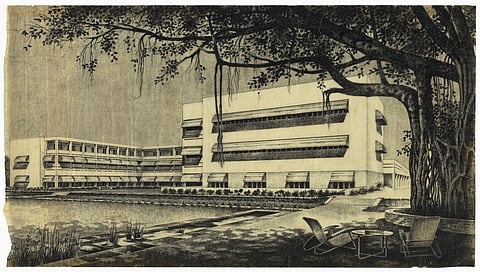
- LIFESTYLE
- FASHION
- FOOD
- ENTERTAINMENT
- EVENTS
- CULTURE
- VIDEOS
- WEB STORIES
- GALLERIES
- GADGETS
- CAR & BIKE
- SOCIETY
- TRAVEL
- NORTH EAST
- INDULGE CONNECT

It was around a century ago, around 1929, two pioneers and friends who shared the same passion for art, design and architecture, Maharaja Yeshwant Rao Holkar II of Indore and the Berlin architect Eckart Muthesius, envisioned the architectural testament, Manik Bagh, Indore. With elements such as walls treated with glass dust to withstand India’s humid weather, curved awnings that shielded monsoon rains, along with simple yet elegant artworks, like pictorial carpets, Cubist paintings in space and lighting fixtures designed as sculptures, this truly was a home to cosmopolitan sensibilities and vintage commodities. The Museum of Art & Photography has collaborated with the Museum für Asiatische Kunst (Museum of Asian Art, Berlin) to present an exhibition curated by Raffael Dedo Gadebusch, who have brought together a collection of art that embraces the story behind Manik Bagh through rare vintage photographs, portraits and catalogues as you delve into a transformative era of Indian history, where architecture, art and design emerged to establish a space that was both revolutionary and personal. Titled Eckart Muthesius and Manik Bagh: Pioneering Modernism in India; curator Raffael gives an insight into what this new exhibition has in store for us.
How did the collaboration between the Museum of Asian Art in Berlin and MAP come about?
MAP is one of the most interesting new museums in India and it has a focus on photography, design and architecture. The MAP-building by Soumitro Ghosh itself is an architectural landmark in Bengaluru. So, it seemed the perfect place for a venue for the Manik Bagh exhibition.
What inspired you to curate Eckart Muthesius and Manik Bagh: Pioneering Modernism in India?
I was fascinated by this very unique and fruitful friendship of two like minded, very young people (Yeshwant and Eckart) from different cultural backgrounds that resulted in India’s first and most iconic building of modernism transcending — like hardly any other building at that time — the ideals of the Bauhaus movement, making it a true synthesis of the arts.
Could you elaborate on the standout features of Manik Bagh’s architecture — such as unique techniques like the walls treated with glass dust and curved awnings, materials and also the blend of German and Indian inspirations?
The palace was not only the perfect Gesamtkunstwerk in the spirit of the Bauhaus but also technically one of the most advanced buildings in Asia at that time. Noteworthy is the extensive use of unusual new materials very suited to the climate, like glass, steel, the so-called German silver (nickel silver) as well as artificial leathers. Lighting fixtures were designed like artworks. Manik Bagh had electric awnings and the most sophisticated air conditioning system of its time that was able to cool, humidify or heat the palace, certainly the first of its kind in India.
How does the exhibition catalogue reflect the spirit of the moment? Could you talk about the articles on display, such as photographs and paintings?
It reflects the avant-garde aesthetics of the late 1920s, early 1930s: elegant linen binding with embossed titles and photographs, the smaller size of the book and a font that recalls the Bauhaus aesthetics, but still creating something new. The very talented young Turkish designer Sefa Pala and Raffael Gadebusch made the catalogue a design piece of its own. The rare vintage photographs by Eckart Muthesius are important documents of the many design and art objects acquired by the maharaja, the maharani and Muthesius through the famous art adviser Henry Pierre Rochér, a dazzling figure in the art circles of Paris and NYC. Furthermore, they reveal Eckart Muthesius being a modernist photographer himself. The watercolours, charcoal drawings and design studies testify to the extraordinary talent of Muthesius also as a draughtsman.
Are there any particular design studies or watercolours featured in the exhibition that stand out to you?
The charcoal drawing of the palace with landscaped, Mughal inspired gardens and a huge Banyan tree with iconic design furniture by Sognot and Marcel Breuer; and the watercolours of the houseboat for the Royal family in Kashmir.
INR 30 onwards. On till March 30. At Kasturba Road.
Written by: Rakshitha B
Email: indulge@newindianexpress.com
X: @al_ben_so